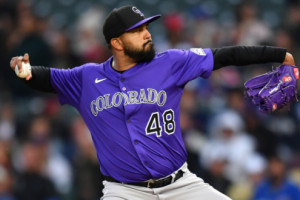10 Definitely Interesting, Possibly Helpful MLB Notes for Friday, March 29th
Welcome to 10 Definitely Interesting, Possibly Helpful Notes! In this column, I’ll work to uncover some interesting bits of information that might shed some light on players from that day’s slate of MLB games. This is not a picks column, nor is it a “fun facts” article – it’s something in between.
I hope you enjoy it, and I hope it helps you think about today’s MLB plays in a new way as you build your DFS lineups. Here are 10 Notes for Friday, March 29th.
1. In 32 starts last season, Gerrit Cole reached double-digit strikeouts on eight occasions; prior to last season, he’d only reached 10 punchouts on six occasions in his entire career (127 starts), dating all the way back to 2013. The changes he made when he arrived in Houston – ditching his sinker in favor of a better four-seamer, deploying his devastating slider more frequently, throwing higher up in the zone – are real, and they’re sustainable. There’s no reason to think Cole will revert back to the low-strikeout form that made him seem and that makes him a steal at just $11,200 at DraftKings On a day with a lot of solid arms, Cole stands alone at the top, and he’s a worthy investment.
2. If you paid any attention to baseball from June-ish onwards last year, you saw German Marquez transform himself into an elite-level strikeout pitcher, and this despite pitching half his games in the pitcher’s nightmarish hellscape that is Coors Field. But it’s not just the strikeouts that make Marquez so interesting; he can also rack up ground balls at a high clip. He was one of four pitchers last year with 28 percent strikeouts and 47 percent ground balls (Patrick Corbin, Charlie Morton, Tyler Glasnow, with Walker Buehler just missing the cut with a 27.9% K rate). That combo should work just fine against a Marlins offense that is about as threatening as a basketful of cute little puppy dogs. It wouldn’t be a surprise to see Marquez keep pace with Cole in total points, and he comes in at $2,000 cheaper at DraftKings ($9,200).

3. Ross Stripling has a 5.1 K/BB rate and a 3.30 ERA over the past two seasons. The only other players to match those numbers: Clayton Kershaw, Max Scherzer, Chris Sale, Corey Kluber, Miles Mikolas. Stripling is an elite control artist, and for now, he’s locked into a rotation spot. As long as he’s wearing Dodger blue, there will be a lurking danger that he’ll be pulled after five innings (and for what it’s worth, Hyun-Jin Ryu was pulled at 82 pitches, even though he was efficient and made it through six innings). That’s a risk that exists for lots of pitchers early in the year, though. His price tag of $9,500 probably prices him out of cash game consideration, but if it looks like ownership will be low, Stripling could make for a nice pivot off the likely high ownership of Marquez.
4. With a pVal of 18.9, Matt Boyd had the sixth-most valuable slider in MLB last year, per Pitch Info. It’s pretty close to an elite offering, and he upped his usage to 31 percent last year (sixth-most in MLB among qualifiers). Throwing a good pitch more is generlaly a good thing. However, it’s still one pitch, and Boyd’s repertoire as a whole has led to middle results, even when his slider is working. His fly ball rate in 2018 (49.9%) was second-highest only to Justin Verlander last year, and he’s in the Rogers Centre, a small, hitter-friendly venue. These are all fair concerns. But that’s why Boyd comes at the reasonable price of $6,600, making him an excellent SP2 option if you can stomach a bit of risk.
5. Trevor Richards allowed a .125 average and posted a 0.62 WHIP this spring. The average is best among 38 qualifiers, and the WHIP is second-best. I know, I know: spring numbers don’t matter, small sample, he’s a Marlins starter. All fair points, I suppose. But 20 strikeouts against 4 walks is encouraging, especially considering that Richards was facing fairly strong opponent quality. Per Baseball Reference, Richards’ opponent quality was 8.2, which translates to something between Triple-A and MLB. He’s at Marlins Park, one of the pitcher-friendliest venues around, and one in which he posted a respectable 3.83 FIP in 62 ⅔ innings last year. “Hey, he’s really not that bad!” or some variation thereof is an argument I’ll be making all year about a whole slew of Marlins starters this year (I drafted Richards, Pablo Lopez, and Caleb Smith anywhere I could get them in season-long fantasy). Richards is a solid tournament play, and he’s a name to monitor moving forward.
6. Only one player in MLB has had a .200 ISO and a strikeout rate below 18 percent in each of the past four seasons: Manny Machado. Machado has quietly been a low-strikeout player all throughout his career, and last year, he cut his K’s down to a career-low 14.7 percent while maintaining a career-high .241 ISO. He’s at the peak of his powers, and he’s got the platoon edge against Derek Holland, a pitcher who improved in many ways last year but still has a fairly large platoon split (.337 wOBA allowed to righties, .209 to lefties in 2018). Holland allowed 19 home runs last year, and every last one of them came at the hands of a right-handed hitter. Today could be the day Machado hits his first of many homers as a member of the Padres.
7. How good is J.D. Martinez? Well, he’s very good, to answer the question. But there’s more. He’s hit .300 and 40 home runs in two straight years, something done by only a select few individuals have done this century (Miguel Cabrera, David Ortiz, Albert Pujols, Alex Rodriguez, Sammy Sosa, Todd Helton Barry Bonds, and if you throw in 1999, Jeff Bagwell and Vladimir Guerrero). On a weaker slate for pitching, Yusei Kikuchi is not a pitcher we’d be eager to attack, but Martinez is a legitimate lefty masher, and he’ll have the platoon advantage, which is always worth targeting.

8. Matt Chapman is known for his nifty glovework, and rightfully so (this winter, I found myself watching random YouTube montages of his highlights. I don’t regret it.). But don’t sleep on work with the bat, either; Chapman has sneaky power. His 93.1 mph average exit velocity last year ranked fifth in MLB behind the Mount Rushmore of Statcast power metric darlings: Judge, Gallo, Stanton, and Cruz. Chapman has also becoming more picky at the plate; the 4.5 percent he chopped off his K rate from 2017 to 2018 represents the 12th-largest improvement in MLB over that span. Against the still-hittable repertoire of the latest iteration of Matt Harvey, Chapman is one of the top third base options of the slate.
9. Matt Carpenter had a .332 ISO against four-seam fastballs last year. That’s really good, 15th-best in all of baseball, actually. Freddy Peralta threw his heater over 77 percent of the time in 2018. If he leaves one in the zone, Carpenter could do some damage. Carpenter’s batted ball numbers are worth noting, as well, given that he’ll have the platoon advantage. Against righties last year, Carpenter had a crazy 50.7% fly ball rate, the third-highest mark in MLB among qualifiers. That ability to elevate pitches from righties allowed him to find success even despite being shifted against more than any other player in MLB. But obviously, I’m burying the lede: more than likely, CheeseIsGood has already told you to play Matt Carpenter at some point today, and I agree. Play Matt Carpenter.
10. Last year, Omar Narvaez was quietly stellar against right-handed pitching. He slashed .297/.371/.466 in 236 PAs, and his 132 wRC+ was second-best in MLB behind only J.T. Realmuto. Nathan Eovaldi is a potential breakout candidate. But there’s a whole slew of great pitchers going on Friday, and the catcher position (as we’ll say all year) is putrid, ugly, vomit-inducing…no…[goes to thesaurus.com] threadbare. For $2,900 at DraftKings, I’ll take a guy with good on-base skills and the platoon advantage at a threadbare position every time.
__________________________________________________________________________________________________________________________________
Thanks for reading! Stats from this article were pulled from RotoGrinders’ PlateIQ tool, FanGraphs, Baseball Savant, Brooks Baseball, Baseball Prospectus, and Baseball Reference.
Check back for more “10 Notes” MLB articles throughout the year, and feel free to leave a question or comment down below!
